Forecasts Differ on Economic Outlook for ’87
- Share via
Consumer spending, the engine that has powered much of the economic recovery since 1982, is running out of steam amid higher inflation, debt and persistently low savings, according to two California-based economic forecasts released Thursday.
“Growth in consumer spending will drop dramatically this year because the jump in inflation will cause a fall-off in the growth of disposable income,” said Daniel T. Van Dyke, a Bank of America vice president and senior economist.
Inflation last year rose at an average rate of 1.9%, reflecting sharply falling energy prices. This year, however, the average will be 3.7%, because of rising prices for energy and imported goods, which have been affected by the cheaper dollar, the bank’s World Information Services reported.
UCLA Forecast More Upbeat
Meanwhile, the UCLA Business Forecast Conference predicted that spending by consumers will increase less than 2% through 1989, a rate that is half the level experienced in 1986. Larry J. Kimbell, a UCLA business economics professor, cited the public’s “persistently low rate of savings,” as well as growing consumer debt, as causes for the curtailment in spending.
But economic forecasting is an inexact science, and analysts at the bank and university disagreed on the prospects of future U.S. economic growth.
In the more downbeat forecast, Bank of America envisioned a lackluster 2.4% growth rate for 1988, largely because of the drop in consumer spending. This development, it found, would offset expected improvements in exports.
By contrast, UCLA foresaw a more optimistic 3% U.S. growth rate for next year, noting that U.S. exports “will be a major factor in increased real GNP (gross national product) growth for the next two years.”
The U.S. economy grew 2.5% in 1986. The bank said the 1987 figure would stay the same, with UCLA predicting 2.8%.
More to Read
Inside the business of entertainment
The Wide Shot brings you news, analysis and insights on everything from streaming wars to production — and what it all means for the future.
You may occasionally receive promotional content from the Los Angeles Times.










